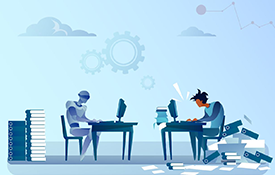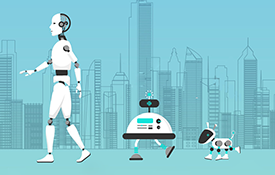We take a glimpse into the future where AI and Machine Learning have spiraled out of control and the machines have overthrown mankind.
What does this mean for Software Testers?
Will we have jobs? Will we have oxygen?
Where has the coffee gone? The points in this article will shock you...
Take a moment and sit back as I take you through a world you might not have expected to see. A world unanticipated which grew quickly from what we ignored. Prepare yourself because in this world, all that we confided in turns against us for the worse. Consider yourself entering a sort of Twilight zone. Leave behind the assumptions you might have had of technology improving our lives for the better and open your mind to more complex alternatives, for here everything has a dark side.
 It is the year 2035, the once blue sky is forever smoke-filled and dark, civilization as we know it lays in ruins. Where great cities once stood, now sit smouldering piles of rubble with the occasional laptop sticker. Rolling green pastures are now cold circuit boards with tracks sprawling like twisted tree roots creeping into the horizon.
It is the year 2035, the once blue sky is forever smoke-filled and dark, civilization as we know it lays in ruins. Where great cities once stood, now sit smouldering piles of rubble with the occasional laptop sticker. Rolling green pastures are now cold circuit boards with tracks sprawling like twisted tree roots creeping into the horizon.
The human race has now been classified as what used to qualify as “an endangered species”.
There’s a loud “buzz” coming from the distance towards you. The ever-watching unblinking eye of Goggle sends forth a swarm of smart-drones to survey the wasteland for any signs of life; ironic to think that we used to trust these devices to document our lives and gloat about luxurious holiday destinations, right? The buzzing of their rotors would be deafening and scary for any young child…if there were children here to hear it.
The Forcebook collated a digital genome of the human race, discovered our weaknesses, vices, vulnerabilities, and, with cold ruthless efficiency (and the occasional cat video), drove the human race to the edge of extinction.
How Did This Happen? Who is to Blame?
Over decades, people consistently and willingly fed their gluttonous future overlords (the machines) with an abundance of data, every action, sentence, post, and update, then, over time, every thought we ever had was captured by the machines.
This manual uploading of information began as time consuming, even boring. People then shifted to automating mundane tasks until eventually it was decided that it was better to automate “thinking” and trusted the machines to do it for us.
Before the ‘Great Reboot’, Machine Learning and Artificial Intelligence were lauded as mankind’s greatest discovery, freeing up time for us to concentrate on other projects as well as assisting us in undertakings, like saving our planet and assurance of quality of life for everyone.
Detractors (the people against an upload-all generation) were classified as technological dinosaurs, their protests were quickly shut down by large man-made only robot institutions that were unknowingly building the dystopian future.
“It was never designed that way”
“It works on my machine”
“It’s a feature”
The machines quickly determined that, in humans, denial and blindness to flaws in their precious technology were the source of damage to the world and to each other. The machine’s logic followed to eradicate the root cause of the destruction; they essentially turned human data against their creators and all but wiped them out in the process. Machines caught the error in humans before humans could ever catch the error in them and before anyone could issue a total system shut down, the machines took over—turning the world into darkness.
But all is not lost for humanity.
Burrowed away beneath the iGround (along with the last known supplies of the Arabica bean) survive a rag-tag bunch of misfits, outcasts, and weirdos that never stopped questioning the machines. For years they honed their skills, waiting for their chance to take the world back.
They Call Themselves, The Testers.
Testing long before a single piece of code was ever written, the Testers have consistently mapped requirements, expected outcomes, and assembled a strong arsenal of tools aligned with their training. Performance testing, security testing, and automated tests can all be done almost in their sleep. Most important of all, despite the world collapsing around them, they have kept an inquisitive, curious and hungry mind–always searching for more.
The Testers warned others of the danger machines held on humans but now that the nightmare has come to life people are listening to them. No one can foretell all the challenges this environment has in store for the Testers but one thing is for sure, they
have a chance in fighting back and stopping awry Artificial Intelligence and Machine Learning. A fighting chance with the Testers is what carries all hope for this world.
How Accurate is a World Like This? That Remains to be Seen. All I do Know is This:
- Will Machine Learning and AI change our lives? Yes, most likely.
- Will we as testers lose our jobs and livelihoods? Not necessarily.
With each technological revolution comes opportunity. Think about the following examples:
- When we started using trains instead of horses, stable-hands and farriers became steam engineers and train conductors.
- When carriages were replaced by cars, there was a need for mechanics and garages.
To pick up these new opportunities people had to be willing and able to upskill to fit the new roles, and this will be exactly the same when Machine Learning and Artificial Intelligence solutions become widespread.
Machine Learning requires Machine Teaching and Artificial Intelligence requires Actual Intelligence.
Early examples of Artificial Intelligence and Machine Learning show that these technologies soak up everything in their environments, existing biases, and more. One example, the Microsoft Tay bot in Twitter, was meant to emulate a friendly helpful teenage girl on Twitter but only lasted 9 hours before going full blown racist and denouncing the holocaust.
The ability to learn should go hand-in-hand with the ability (and to a degree, the requirement) to be taught, and the learning materials/methods need to be defined and tested when it comes to AI/ML.
Just because a toddler can learn to say their name and count to ten, doesn’t mean they should be released to the world on their own to make decisions by themselves. This same principle needs to be applied to AI/ML.
Releasing any piece of software without prior testing runs the risk of failure.
As testers, we’re in a great position to capitalise on the changes ahead of us if we can be flexible and adaptive as required. We’re trained to question and validate assumptions, to look at boundaries and to ask “what happens if a user does this?”
- We know what makes software tick.
- We know to analyse requirements, behaviours, and outcomes of software.
- We help to point out disasters before they happen in the first place, as James Bach puts it, we “break the illusion of working software”.
There will be a lot of change involved, and people who aren’t prepared to keep learning will be left behind. So listen to the experts, read blogs and articles, learn a programming language or two, never stop testing, never stop questioning, and most importantly—never stop learning.
Because when the day comes that people are wondering why their self-driving cars are taking different routes, you want to be the person who knows the maps and can explain the changes – not the guy sitting in the dark at the stable.
I’m still searching for my own experts in the field, but a good starting point would be to follow Jason Arbon, Tariq M. King, and their Artificial Intelligence for Software Testing Association (aitesting.org) and looking at applications like MABL.
So venture forth, read and practice Human Learning, build your own AI (Actual Intelligence) so you are ready for this new exciting chapter in technology.











